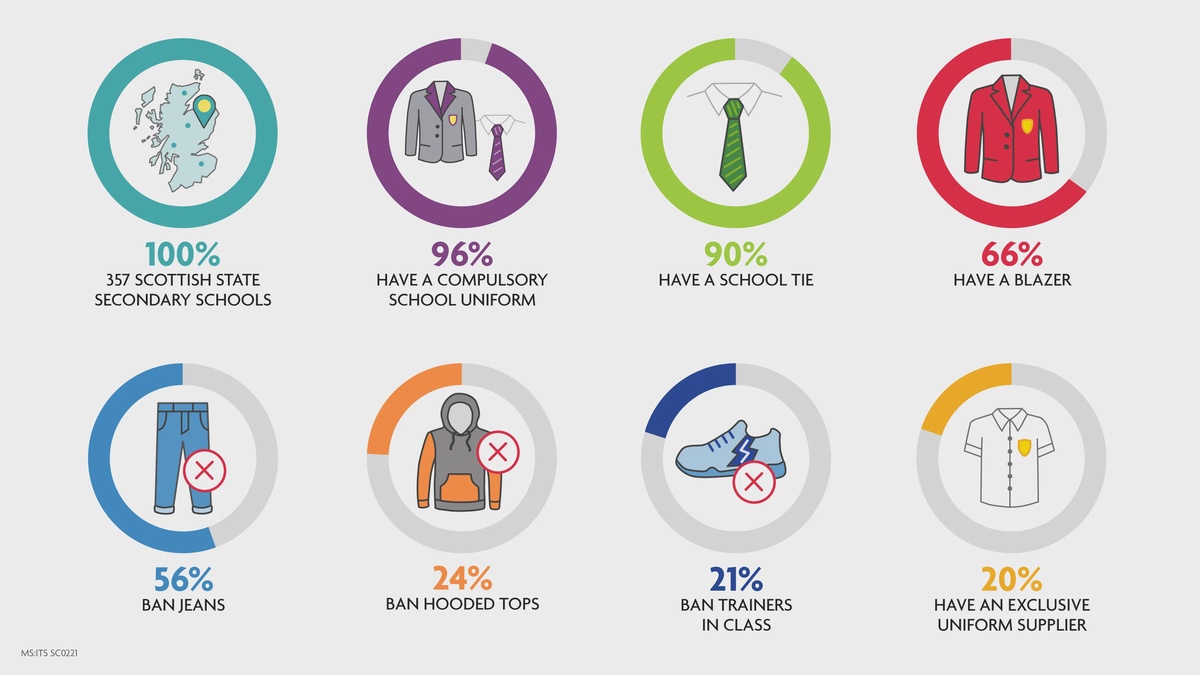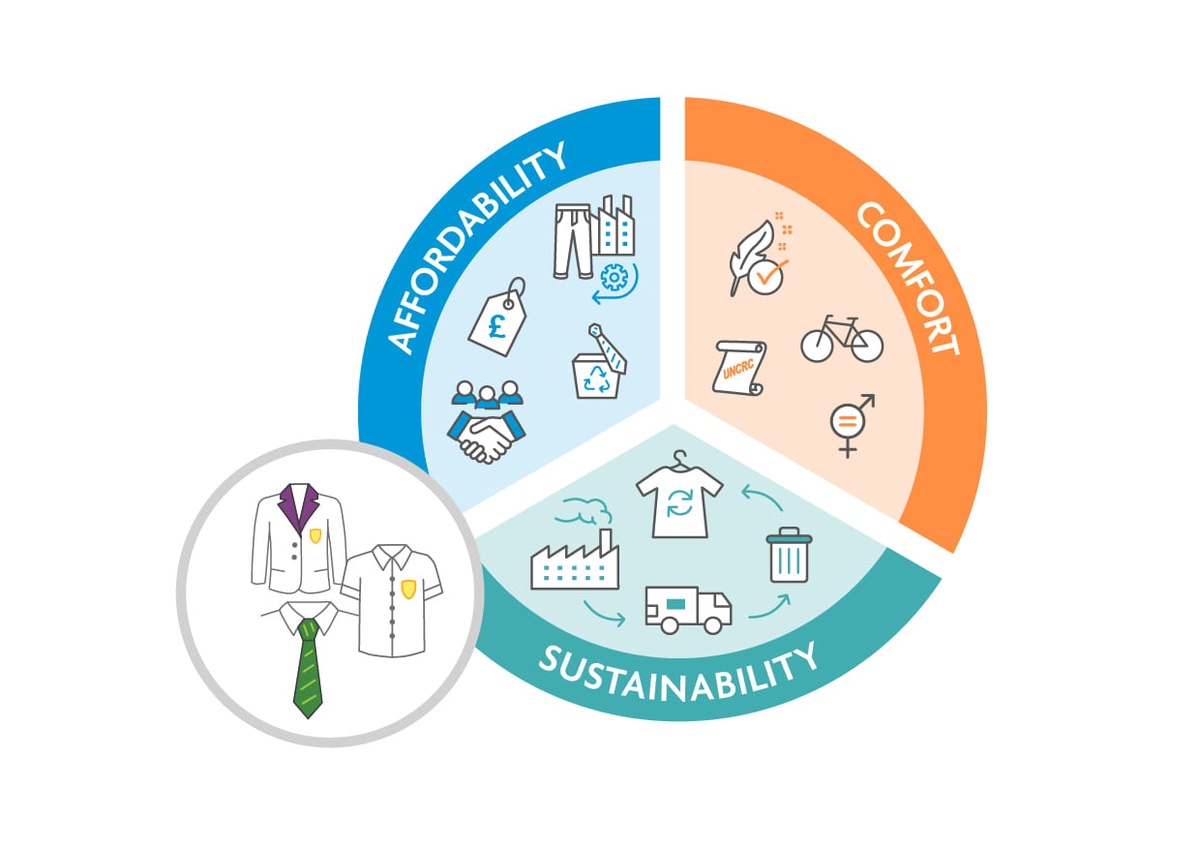School clothing policies in state funded secondary schools in Scotland were analysed in terms of the style of the uniform, discipline, equality and children's rights, what was banned and affordability.

Dr Rachel Shanks has focused on the affordability of school uniform and support to families on low incomes through the school clothing grant in Scotland. She produced a briefing in 2020, Affordability of secondary school uniform in Scotland: Policy briefing and another briefing in 2022 School Clothing Grant in Scotland Policy Briefing.
The reasons that were given for school uniforms in state funded secondary schools in Scotland were:
- To foster school ethos, identity, pride and a sense of belonging
- To prevent competition, discrimination, reduce bullying and improve discipline
- For safety, security and to reduce truancy
- Financial benefits (cheaper than wearing own clothes)
- To enhance the reputation of the school
- To prepare young people for the workplace (employability)
- To improve attitudes to learning and improve standards
The current focus of the research is the affordability, sustainability and comfort of school uniform.

Current work
Focusing on school uniform in a holistic way to consider:
- Affordability - the cost to those buying items and consideration to issues of exploitation of workers, child labour etc. in how garments are produced.
- Sustainability - thinking of this right through the supply chain, principles of fair and ethical trade and how/where garments are disposed of at end of use.
- Comfort - covering not only fabric and texture but also allergies, stigma, gender, transgender, culture, religious beliefs.
The short framework also puts this in the context of children's rights and legislation.
At this stage we are trying to get feedback on the framework which could inform discussions at national, local and school levels. Below are links to the framework and the feedback form:
Survey for school uniform and clothing banks
School Uniform Dress Codes and Appearance Policies Participant Information Sheet
Further Reading
- Briefings
- Books and book chapters
-
- Shanks, R., Ovington, J., Cross, B. and Carnarvon, A. (2023) School Uniforms: New Materialist Perspectives, Palgrave Macmillan
- Shanks, R. (2023) Pupil Participation in Secondary School Uniform Policies in Scotland, In Shanks, R., Ovington, J., Cross, B. and Carnarvon, A. School Uniforms: New Materialist Perspectives, Palgrave Macmillan.
- Shanks, R. (2023) Why Do Girls Have to Wear Ties at School in the UK? In Shanks, R., Ovington, J., Cross, B. and Carnarvon, A. School Uniforms: New Materialist Perspectives, Palgrave Macmillan.
- Shanks, R. (2023) The Materiality and Materials of School Uniforms at a Local and Global Level, In Shanks, R., Ovington, J., Cross, B. and Carnarvon, A. School Uniforms: New Materialist Perspectives, Palgrave Macmillan.
- Journal articles
-
- Friedrich, J. & Shanks, R. (2023) 'The prison of the body': school uniforms between discipline and governmentality, Discourse: Studies in the Cultural Politics of Education, 44:1, 16-29
- McKinney, S. J., Graham, A., Hall, S., Hunter, K., Jaap, A., Lowden, K., MacDougall, L., McKendrick, J. H., Mtika, P., Moscardini, L., Reid, L., Ritchie, M., Robson, D., Shanks, R., Stettin, S., & Wilson, A. (2023). Beyond the Pandemic - Poverty and School Education in Scotland. Scottish Educational Review, 54(2), 238-264
- Olsson, A., & Shanks, R. (2022). Employability and school uniform policies: Projecting the employer's gaze. Childhood, 29(4), 628-645
- Shanks, R., & McKinney, S. J. (2022). Cost and Affordability of School Uniform and Child Poverty. Scottish Educational Review, 54(1), 26-48
- The Conversation
- Blog Posts
-
- School Uniform Policy in Scottish schools: Control and Consent, European Educational Research Association
- School uniform guidance consultation in Scotland: What to consider, University of Aberdeen
- Video and podcasts
-
- Let's Talk Education Research Episode 29: School uniform policy and research in Ireland and Scotland with Dr Majella McSharry and Dr Rachel Shanks
- Emma & Tom Talk Teaching, School Uniform with Dr Rachel Shanks
- The future of school uniform in Scotland, Video on University of Aberdeen's YouTube channel
- Is there a point to compulsory school uniform? With Dr Rachel Shanks, Susan Pallister Podcast
- School uniforms: Taken for granted but are they fit for purpose? University of Aberdeen Café Connect episode 16
- Other useful resources
-
- Child Poverty Action Group - Affordable School Uniforms: A Guide
- The Children's Society - The Wrong Blazer 2020 - report on rising school uniform costs in the UK
- Halo Collective - alliance of organisations and individuals working to create a future without hair discrimination
- Let Clothes Be Clothes - Campaign to challenge gender marketing in children's clothing
- Money Saving Expert - School uniform MoneySaving tips
- Llywodraeth Cymru/ Welsh Government - School Essentials Grant
- Northern Ireland - School uniform and uniform grants
- Scottish Government - Help with school clothing costs
- UK School uniform guidance for England
